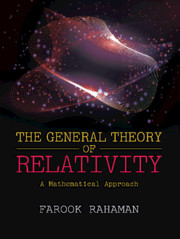Book contents
- Frontmatter
- Dedication
- Contents
- List of Figures
- List of Tables
- Preface
- Acknowledgments
- Chapter 1 Tensor Calculus — A Brief Overview
- Chapter 2 Geodesic
- Chapter 3 Einstein Field Equations
- Chapter 4 Linearized Gravity
- Chapter 5 Lie Derivatives and Killing’s Equation
- Chapter 6 Spacetimes of Spherically Symmetric Distribution of Matter and Black Holes
- Chapter 7 Particle and Photon Orbits in the Schwarzschild Spacetime
- Chapter 8 Causal Structure of Spacetime
- Chapter 9 Exact Solutions of Einstein Equations and Their Causal Structures
- Chapter 10 Rotating Black Holes
- Chapter 11 Elementary Cosmology
- Chapter 12 Elementary Astrophysics
- Appendix A Extrinsic Curvature or Second Fundamental Form
- Appendix B Lagrangian Formulation of General Relativity
- Appendix C 3+1 Decomposition
- Bibliography
- Index
Chapter 4 - Linearized Gravity
Published online by Cambridge University Press: 24 March 2021
- Frontmatter
- Dedication
- Contents
- List of Figures
- List of Tables
- Preface
- Acknowledgments
- Chapter 1 Tensor Calculus — A Brief Overview
- Chapter 2 Geodesic
- Chapter 3 Einstein Field Equations
- Chapter 4 Linearized Gravity
- Chapter 5 Lie Derivatives and Killing’s Equation
- Chapter 6 Spacetimes of Spherically Symmetric Distribution of Matter and Black Holes
- Chapter 7 Particle and Photon Orbits in the Schwarzschild Spacetime
- Chapter 8 Causal Structure of Spacetime
- Chapter 9 Exact Solutions of Einstein Equations and Their Causal Structures
- Chapter 10 Rotating Black Holes
- Chapter 11 Elementary Cosmology
- Chapter 12 Elementary Astrophysics
- Appendix A Extrinsic Curvature or Second Fundamental Form
- Appendix B Lagrangian Formulation of General Relativity
- Appendix C 3+1 Decomposition
- Bibliography
- Index
Summary
Newtonian Gravity
Newton's theory of gravitation can be treated as a three-dimensional field theory. The gravitational field is characterized by a scalar field ϕ(x; y; z). This satisfies
where G = 6.67×10-8cm3 gm-1 sec-2 is the gravitational constant and ρ is the mass density of matter in space that produces the gravitational field. The above equation is known as the Poisson equation.
Proof of Poisson Equation
Let us consider a mass M occupying a volume V, which is enclosed by a surface S. The gravitational flux passing through the elementary surface dS is given by g:ndS, where g is gravitational vector field (also known as gravitational acceleration) and n is the unit outward normal vector to S. Now, the total gravitational flux through S is
We know is the elementary solid angle dΩ subtended at M by the elementary surface dS, where er is the radial unit vector. Thus,
Applying Gauss divergence theorem to the left-hand side, we get
Thus, we get
Using g = -∇ϕ (gravity is a conservative force, therefore, it can be written as the gradient of a scalar potential ϕ, known as the gravitational potential), we finally obtain
The gravitational field (F) is proportional to the negative of ∇ϕ, i.e.,
This is the force acting on a particle of mass m.
For a single mass M that produces the potential ϕ, then the solution of Poisson equation is given by
The force acting on another particle with mass m will be
The ratio of gravitational force and electrical force between two electrons is given by
Here, ke is Coulomb's constant with me and e are mass and charge of the electron, respectively. This indicates that the gravitational force is very weak.
Exercise 4.1
Find the gravitational potential inside and outside of a sphere of uniform mass density having a radius R and a total mass M. Normalize the potential so that it vanishes at infinity.
Hints:
The mass density in the sphere is (see Fig. 8)
For spherically symmetric distribution of matter, the gravitational potential ϕ is a function of radius r only.
Information
- Type
- Chapter
- Information
- The General Theory of RelativityA Mathematical Approach, pp. 85 - 94Publisher: Cambridge University PressPrint publication year: 2021
